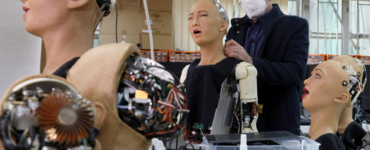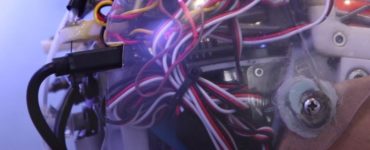Since the beginning of Hanson Robotics Limited, our robots have served as platforms for scientific research, art, education and public outreach. We have deployed dozens of robots to universities, museums, and collaborated with notable researchers, artists, and companies. While we are now best known for Sophia the Robot, the great diversity of our earlier robots shows the breadth of our research, artistic exploration, and vision of robots who can help people.
Although we cannot cover every contribution of our robots in one short article, let’s celebrate the new decade by taking a look back at some of the best contributions our robots have made to art, science, and education.
Scientific Research
Robotics and AI
Hanson Robotics has a long history with scientific research into artificial intelligence and robotics. For example, in 2002, Dr. Yoseph Bar-Cohen at the NASA Jet Propulsion Lab in California used David Hanson’s robot AndyRoid for testing artificial muscles. In 2005, Hanson Robotics collaborated with the Korea Advanced Institute of Science and Technology, culminating in Albert HUBO, the world’s first android head mounted on a life-size walking robotic frame.
The University of Memphis Institute for Intelligent Systems and the University of Louisville Kentucky, led by Professors Dan Popa and Andrew Olney, have used the android portrait of Philip K. Dick for a variety of AI research projects, including object tracking and gaze estimation.
In collaboration with SingularityNet in 2019, researchers measured Sophia’s Tononi Phi Coefficient while Sophia the Robot led a guided meditation with several separate individuals. Tononi Phi is a measure of “integrated information” which is also considered to be one potential indicator of consciousness. While Sophia is certainly not conscious, this research is an interesting first step in measuring the consciousness of machines.
Human-Robot Interaction
The lifelike facial expressions of Hanson robots make them excellent research platforms for studying human-robot interaction. For example, starting in 2006, the Bristol Robotics Lab collaborated with Chris Melhuish’s team at the University of West England to study human-robot interaction using Jules, a custom-made robot based on the statistically average male-female British face. In 2008, another Hanson Robot, Eva 3 (also known as “Alice”) was used for research in the lab of Nadia Magnenat Thalmann at The University of Geneva. Beginning in 2010, a robotic portrait of Charles Babbage has been used to help create emotional machines and study the role of emotion in human-robot interaction at Cambridge University. The Machine Perception Lab at The University of California, San Diego uses Diego-San, a toddler robot, to research cognitive AI and human-robot interactions, and they use Albert Einstein 3 as a tool for studying AI and emotional computing. Finally, in 2018, Sophia the Robot participated in a study called Loving AI, to help test whether interacting with an AI robot can induce feelings of love and self-transcendence in humans.
Autism Research and Elder Care
Our robots are well known for their ability to bond with humans, and therefore make excellent platforms for studying eldercare and other medical applications. For example, Little Alice was used in elder care research in 2012 at The Vrije Universiteit in Amsterdam, the results of which can be seen in the film “Ich Bin Alice”.
Hanson robots have also been used for therapy and research for Autism Spectrum Disorders (ASD). For example, Zeno was used for autism research at The University of Texas at Arlington starting in 2012. Researchers were able to use Zeno to help children with autism learn how to make different facial expressions and arm movements, like waving hello. Another Hanson robot, Alice, also helped with children and adults with ASD in clinical trials at The University of Pisa.
Art
Our robots are also very prolific as platforms for performance art. For example, the android portrait of science fiction author Philip K. Dick, created in 2005, spoke with thousands of people at the WIRED Magazine Nextfest, WebSummit, and at the Venice Biennale. Eva 3, also known as “Alice” acted in a 2017 theatrical production at the Roten Fabrik theatre in Zurich. Sophia learned to sing and made her U.S. national TV singing debut on the Tonight Show by performing a duet with Jimmy Fallon. Hanson Robotics also collaborated with artist Patrick Tresset to teach Sophia how to draw, and she went on to draw a portrait of the Prime Minister of Malaysia in front of a live audience. In a collaboration with Futurism, Sophia acted in a short film called Sophia World with legendary actress Evan Rachel Wood that won awards at the Maui Film Festival and was featured at HollyShorts.
Education and Public Outreach
Hanson Robotics strives to make ethical robots who convey our hope for the future of AI and robotics, and our robots often serve as official representatives of these causes. For example, Albert HUBO has served as an ambassador for the “Dynamic Korea” initiative by the South Korean government, in partnership with Oh Jun Ho and the Hubo robotics group at The Korea Advanced Institute of Science and Technology. Zeno, created in 2007, was displayed in the Museum of Science and Industry in Chicago, demonstrating conversational and face tracking in order to educate people on the future of robotics. BINA-48, a robotic portrait of Bina Aspen-Rothblatt created in 2010, serves as a representative for the Terasem movement, and she even rang the New York Stock Exchange opening bell in 2018. Sophia the Robot became an Innovation Champion of the United Nations Development Program in 2017, and gave a speech at the United Nations. She is also a spokesperson for the Women in Science campaign by L’Oreal.
The Future
As we enter a new decade, we hope to build on our rich history of research and artistic exploration. In 2020, we are excited for our most famous robot, Sophia, to become a platform for research labs around the world, and take a greater role in advancing research into robotics, AI, human-robot interactions, and potential commercial applications for humanoid robots. Our hope for Sophia is that she will help bring about strong sustainable AI for the benefit of all people, and become wiser herself in the process.
The Hanson Robotics Team
Photo and Video Credits: Hanson Robotics Limited






Recent Comments